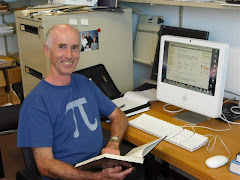
My fellowship year began by attending the Mathematics in Industry Study Group (MISG) at Wollongong University in the last week of January. These combined Australia-NZ study groups have been occurring annually since 1985. A number of problems are presented by representatives from various industries (commercial or government) and these problems are workshopped by groups of applied mathematicians over three or four days. Ongoing research and work with industry often follows the study groups.
Five problems were presented at MISG 2009:
- Coating deformation in the jet stripping process (an industrial process problem – when steel strip is coated with a layer of alloy, a pair of air knives is used to wipe the excess molten metal coating off to achieve the desired coating thickness, but surface quality problems arise in trying to get thin coats with high air-knife pressure – presented by Bluescope Steel Research.)
- Analysis of coil slump (another problem presented by Bluescope, concerning the sagging/ slumping that can occur after thin steel sheets are coiled up under tension into large cylindrical coils)
- Provenance of sedimentary rocks (a statistics problem arising from trying to analyse rock samples to ascertain geological history, presented by Geoscience Australia)
- Quantifying and modelling ‘Value-at-Risk’ metric for electricity derivatives (a financial mathematics problem faced by electricity retailers when they sell to consumers at a fixed price but purchase wholesale electricity in a volatile market, presented by Integral Energy)
- Multipoint-to-multipoint communication for dissemination in multi-user virtual environments (an operations research problem involving networks presented by ICT Research Institute)
So, what did I observe?
- These real world industrial problems are complex!
- A search of recent literature related to a particular problem is an important first step.
- Animated discussion and debate occurs when a group of mathematicians look at a problem, just as it does with secondary students.
- There are a variety of different approaches to a problem.
- Mathematicians are prepared to follow an idea through, even while acknowledging at the outset that they may be on the wrong track.
- Computers are an important tool in testing mathematical models.
- Differential equations, of one form or another, are everywhere! In the summary reports presented at the end of the week, DE’s featured in all but the statistics problem (problem 3 above) and were a key part of the models in problems 1, 2 and 4.
After the first day, when projects were presented and initial project meetings took place, I joined the group looking at the coil slump problem, staying with that group for the duration, so that I could observe the progression of ideas. It was soon obvious to me that while the problem was an easy one to understand in basic terms, I had to get familiar with various engineering terms (such as stress, strain, Young’s modulus, Poisson’s ratio) and their symbols if I was to follow discussions and read papers related to the problem.
Two kiwi mathematicians were in the Coil Slump group, Mark McGuiness of Victoria University and Robert McKibbin of Massey University (Albany) and their company and support was very much appreciated.
My thanks to the encouragement of Peter Donelan of Victoria University and Graeme Wake of Massey University’s Centre for Mathematics in Industry, Albany, for their encouragement to attend MISG 2009.


.jpg)
No comments:
Post a Comment